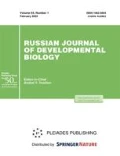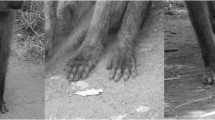Abstract—
The ratio of the lengths of the second and fourth fingers (2D : 4D) is used as a marker of prenatal androgenization. A similar ratio of finger lengths 2D : 4D was found in humans and many animal species. Morphological markers of prenatal effects are important in population studies. The 2D : 4D digit ratio in males and females of a water vole (Arvicola amphibius L.) was measured. The analysis of the dependence of this index on gender and the morphophysiological characteristics of the mother (body weight after parturition, testosterone level during pregnancy) was carried out. A similarity was found between littermates in terms of finger index. It was found that the androgen status of the mother during pregnancy and the body weight of the mother after parturition reliably affect the 2D : 4D ratio. The conclusion about the possibility of using the 2D : 4D digit ratio in environmental population studies as a marker of prenatal hormone-related maternal effects was made.


Similar content being viewed by others
REFERENCES
Auger, J., Le Denmat, D., Berges, R., et al., Environmental levels of oestrogenic and antiandrogenic compounds feminize digit ratios in male rats and their unexposed male progeny, Proc. R. Soc. B, 2013, vol. 280, no. 1768, p. 20131532.
Bailey, A.A., Wahlsten, D., and Hurd, P.L., Digit ratio (2D:4D) and behavioral differences between inbred mouse strains, Genes Brain Behav., 2005, vol. 4, pp. 318–323.
Breedlove, S.M., Cooke, B.M., and Jordan, C.L., The orthodox view of sexual differentiation of the brain, Brain Behav. Evol., 1998, vol. 54, pp. 8–14.
Brown, W.M., Finn, C.J., and Breedlove, S.M., Sexual dimorphism in digit-length ratios of laboratory mice, Anat. Rec., 2002a, vol. 267, no. 3, pp. 231–234.
Brown, W.M., Hines, M., Fane, B., et al., Masculinized finger length patterns in human males and females with congenital adrenal hyperplasia, Horm. Behav., 2002b, vol. 42, no. 4, pp. 380–386.
Butovskaya, M.L., Burkova, V.N., and Fedenok, Yu.N., Finger index as an indicator of prenatal androgenization and its relationship with morphometric and behavioral characteristics in humans, Etnogr. Obozr., 2015, no. 2, pp. 99–116.
Caanen, M.R., Kuijper, E.A., Hompes, P.G., et al., Mass spectrometry methods measured androgen and estrogen concentrations during pregnancy and in newborns of mothers with polycystic ovary syndrome, Eur. J. Endocrinol., 2016, vol. 174, pp. 25–32.
Dean, A. and Sharpe, R.M., Clinical review: anogenital distance or digit length ratio as measures of fetal androgen exposure: relationship to male reproductive development and its disorders, J. Clin. Endocrinol. Metab., 2013, vol. 98, no. 6, pp. 2230–2238.
Gooderham, K.L. and Schulte-Hostedde, A.I., Does 2D:4D predict fitness in a wild mammal?, Can. J. Zool., 2012, vol. 90, pp. 93–100.
Jeevanandam, S. and Muthu, P.K., 2D:4D ratio and its implications in medicine, J. Clin. Diagn. Res., 2016, vol. 10, no. 12, pp. CM01–CM03.
Khairullin, R.M., Filippova, E.N., Butov, A.A., et al., The linear dependence of the finger index values (2D:4D) in males, Vestn. Mosk. Univ., Ser. 23: Antropol., 2011, no. 2, pp. 16–24.
Khairullin, R.M., Fomina, A.V., and Ainullova, N.K., Variability of finger index values 2D:4D in wild and laboratory animals, Fundam. Issled., 2013, no. 6, pp. 611–618.
Lilley, T., Laaksonen, T., Huitu, O., and Helle, S., Maternal corticosterone but not testosterone level is associated with the ratio of second-to-fourth digit length (2D:4D) in field vole offspring (Microtus agrestis), Physiol. Behav., 2010, vol. 99, pp. 433–437.
Lutchmaya, S., Baron-Cohen, S., Raggatt, P., et al., 2nd to 4th digit ratios, fetal testosterone and estradiol, Early Hum. Dev., 2002, vol. 77, pp. 23–28.
Manning, J.T., Scott, D., Wilson, J., et al., The ratio of 2nd to 4th digit length: a predictor of sperm numbers and concentrations of testosterone, lutenizing hormone and oestrogen, Hum. Reprod., 1998, vol. 1311, pp. 3000–3004.
Mills, S.C., Grapputo, A., Jokinen, I., et al., Testosterone-mediated effects on fitness-related phenotypic traits and fitness, Am. Nat., 2009, vol. 173, no. 4, pp. 475–487.
Navarro, C., Lope, F.D., and Moller, A.P., Digit ratios (2D:4D), secondary sexual characters and cell-mediated immunity in house sparrows Passer domesticus,Behav. Ecol., 2007, vol. 61, no. 8, pp. 1161–1168.
Nazarova, G.G. and Evsikov, V.I., Physical state of mother at the period of pregnancy and sexual maturation of descendants-sons of the water vole (Arvicola terrestris L.), Zh. Evol. Biokhim. Fiziol., 2010, vol. 46, no. 2, pp. 143–147.
Nelson, E. and Shultz, S., Finger length ratios (2D:4D) in anthropoids implicate reduced prenatal androgens in social bonding, Am. J. Phys. Anthropol., 2010, vol. 141, pp. 395–405.
Paul, S.N., Kato, B.S., Cherkas, L.F., Andrew, T., and Spector, T., Heritability of the second to fourth digit ratio (2D:4D): a twin study, Twin Res. Hum. Gen., 2006, vol. 9, no. 2, pp. 215–219.
Peichel, C.L., Prabhakaran, B., and Voght, T.F., The mouse Ulnaless mutation deregulates posterior HoxD gene expression and alters appendicular patterning, Development, 1997, vol. 124, pp. 3481–3492.
Robinson, S.J. and Manning, J.T., Ratio of 2nd to 4th digit length and male homosexuality, Evol. Hum. Behav., 2000, vol. 21, no. 5, pp. 333–345.
Saino, N., Rubolini, D., Romano, M., and Boncoraglio, G., Increased egg estradiol concentration feminizes digit ratios of male pheasants (Phasianus colchicus), Naturwissenschaften, 2007, vol. 94, no. 3, pp. 207–212.
Tabibnia, G., Cooke, B.M., and Breedlove, S.M., Sex difference and laterality in the volume of the mouse dentate gyrus granule cell layer, Brain Res., 1999, vol. 827, pp. 41–45.
Tan, U. and Kutlu, N., Relationships among weights of right and left cerebral hemispheres and right minus left brain weight in right- and left-pawed male and female cats: importance of body weight, Int. J. Neurosci., 1993, vol. 691, pp. 53–66.
Voracek, M. and Dressler, S.G., Brief communication: familial resemblance in digit ratio (2D:4D), Am. J. Phys. Anthropol., 2009, vol. 140, no. 2, pp. 376–380.
Wisniewski, A.B., Sexually-dimorphic patterns of cortical asymmetry, and the role for sex steroid hormones in determining cortical patterns of lateralization, Psychoneuroendocrinology, 1998, vol. 235, pp. 519–547.
Yan, R.H.Y., Bunning, M., Wahlsten, D., et al., Digit ratio (2D:4D ratio) differences between 20 strains of inbred mice, PLos One, 2009, vol. 4, no. 6, p. 5801.
Yuzhik, E.I., Proskurnyak, L.P., and Nazarova, G.G., Dynamics of morphophysiological characteristics in female water voles (Arvicola amphibius L.) during pregnancy, Zh. Evol. Biokhim. Fiziol., 2013, vol. 49, no. 4, pp. 290–295.
Yuzhik, E.I., Proskurnyak, L.P., and Nazarova, G.G., Correlations of reproductive parameters of water vole females (Arvicola amphibius) with morphometric and hormonal characteristics, Zh. Evol. Biokhim. Fiziol., 2015, vol. 51, no. 2, pp. 122–126.
Zhang, C., Dang, J., Pei, L., et al., Relationship of 2D:4D finger ratio with androgen receptor CAG and GGN repeat polymorphism, Am. J. Hum. Biol., 2013, vol. 25, no. 1, pp. 101–106.
Zheng, Z. and Cohn, M.J., Developmental basis of sexually dimorphic digit ratios, Proc. Natl. Acad. Sci. U. S. A., 2011, vol. 108, no. 39, pp. 16289–16294.
ACKNOWLEDGMENTS
The authors are grateful to the reviewers for their valuable comments and suggestions for finalizing the manuscript.
Funding
This work was carried out within the Program of Fundamental Scientific Researches of State Academies of Sciences for 2013–2020 (project no. VI.51.1.8).
Author information
Authors and Affiliations
Corresponding authors
Ethics declarations
COMPLIANCE WITH ETHICAL STANDARDS
Conflict of interest. The authors declare that they have no conflict of interest.
Statement on the welfare of animals. All applicable international, national, and/or institutional guidelines for the care and use of animals were followed.
AUTHOR CONTRIBUTIONS
G.G. Nazarova—planning experiments, taking fingerprints and measuring finger lengths, statistical data processing, and participating in writing the text of the article; L.P. Proskurnyak—breeding animals; E.I. Yuzhik—taking blood, determining the level of testosterone, and participating in writing the text of the article.
Additional information
Translate by V. Mittova
Rights and permissions
About this article
Cite this article
Nazarova, G.G., Proskurnyak, L.P. & Yuzhik, E.I. Dependence of the Ratio of the Lengths for the Second and Fourth Fingers (2D : 4D) on the Prenatal Development Conditions in Water Vole (Arvicola amphibius L.). Russ J Dev Biol 51, 65–69 (2020). https://doi.org/10.1134/S1062360420010051
Received:
Revised:
Accepted:
Published:
Issue Date:
DOI: https://doi.org/10.1134/S1062360420010051




